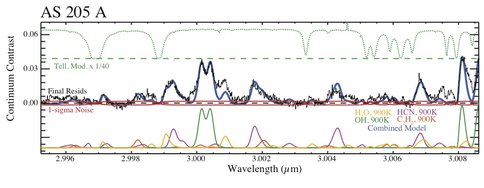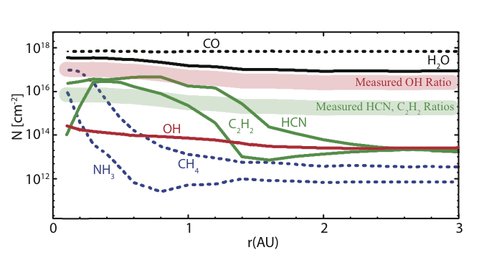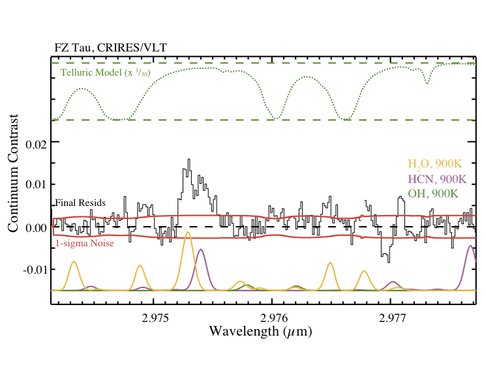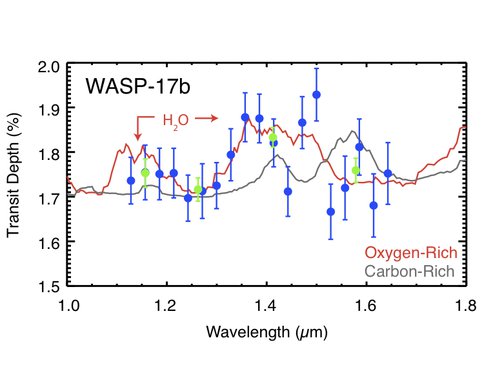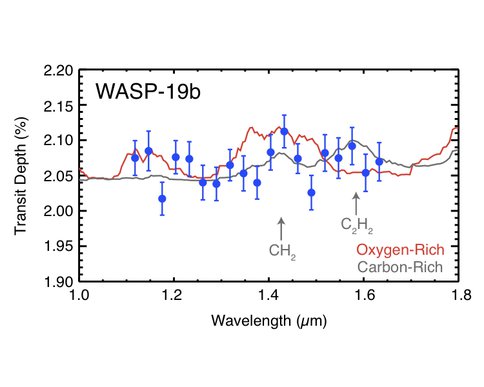2012 Annual Science Report
 NASA Goddard Space Flight Center
Reporting | SEP 2011 – AUG 2012
NASA Goddard Space Flight Center
Reporting | SEP 2011 – AUG 2012
NIR Spectroscopic Observations of Circumstellar Disks Around Young Stars
Project Summary
As a research scientist in the Planetary Systems Laboratory at NASA GSFC, A. Mandell studies the formation and evolution of planetary systems and the structure and composition of the atmospheres of extra-solar planets utilizing near-infrared spectroscopy. Mandell’s current observing campaigns focus primarily on ground-based and space-based spectroscopy of circumstellar disks and extrasolar planetary transits and secondary eclipses using instruments on the Hubble Space Telescope, the Keck telescope and the Very Large Telescope. Additionally, Mandell assists as a co-investigator on computational studies of terrestrial planet formation and evolution using N-body simulations of planetary accretion.
Project Progress
Using the NIRSPEC instrument on the Keck telescope and the CRIRES instrument on the VLT, we have made the first NIR detection of emission from organic molecules in the inner regions of circumstellar disks. We have successfully detected HCN and C2H2 in the L band for the first time in the T Tauri stars AS 205 A, DR Tau, and RU Lup (Mandell et al. 2012; Figure 1), and combined with additional sensitive upper limits for CH4 in DR Tau, we can constrain the emitting region to close to 1 AU (Figure 2). Measuring multiple molecular tracers in a single source (HCN, H2O, OH, and C2H2) at once allows us to accurately compare quantities such as the relative Doppler velocity shifts and molecular abundances, and preliminary analysis suggests there may be two separate velocity components – a disk component in Keplerian rotation around the star, and a slow disk wind that is being released from the surface of the disk (Figure 3).
Figure 1: Previous CRIRES data for the bright T Tauri star AS 205 A, demonstrating the detection of molecular features using our data reduction algorithms. The photon-limited S/N is ~600, and distortions from telluric contamination are completely removed. Emission lines from H2O, OH, and HCN, and C2H2 are clearly detected across multiple detectors.
Figure 2: Plot of model chemical abundances from Agundez et al. 2008 (lines), with our measured abundance ratios overplotted in shaded regions. Our results match well with expected values for the inner disk except for OH, which is most likely radiatively
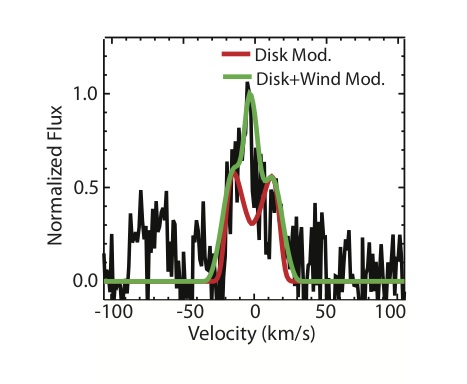
Figure 3: Trace for a single HCN transition from AS 205 A (black), with different disk models overplotted. A slow disk wind w/ a Keplerian disk is required to fit the data.
These new molecular gas tracers will allow us to constrain the disk conditions in the region where planets are forming, providing information on disk structure (e.g. inner gas evacuation, vertical temperature gradient, and dust coagulation timescales) and composition (e.g. condensation fronts, C/O ratio) and aiding in further improvements to computational planet formation and disk evolution models. We are now extending this work to characterize a full suite of molecular species in a larger sample of disks of different masses and ages, in order to better understand the chemical balance and thermal conditions in different environments and evolutionary states. We have just concluded a large observing program with the VLT/CRIRES, with several detections already identified (i.e. Figure 4), and we are combing through previous observations with NIRSPEC using our new data reduction tools to identify emission from these extremely weak emission features. This work will also lay the groundwork for observations of circumstellar disks with the next generation of near-IR and mid-IR instruments.
Figure 4: New detection of H2O and HCN in a T Tauri star from our large CRIRES program. We have detections in more than half of our sources, and we should be able to place excellent contraints on the variations in molecular ratios in a range of circumstellar disks.
NIR Characterization of Exo-planet Atmospheres with HST and Keck
Over the last year we have initiated several observing programs to investigate the atmospheres of hot exoplanets using transit spectroscopy. Transiting exoplanets have orbital inclinations aligned such that they cross in front of their parent star with respect to our line of sight. Low-resolution spectroscopic or multi-band observations of exoplanet transits and secondary eclipses (when the planet passes behind the star) in the NIR can provide information on the thermal and chemical structure of exoplanet atmospheres by observing the emission from within molecular bands (which probe the upper atmosphere) as well as outside of molecular bands (which probe deeper into the atmosphere), and are therefore sensitive to both changes in temperature structure and changes in chemical composition.
One of the best current instruments for low-resolution ultra-stable NIR spectroscopy is the Wide-Field Camera 3 (WFC3) on the Hubble Space Telescope. WFC3 provides slitless spectroscopy covering the wavelength range from 1.1 to 1.7 microns, which covers several molecular bands including H2O, CH4 and other hydrocarbons. As a co-investigator on a large Cycle 18 program with WFC3 (P.I. D. Deming), I am in the process of analyzing data for several hot exoplanets. We have achieved a preliminary precision for the total transit depth of 2×10-4, which allows us sufficient contrast to marginally detect the difference between the continuum and the presence of water in absorption (see Figure 5). We can also test for planets that may be carbon-rich compared with the sun; these planets would show CH4 and possibly C2H2 absorption instead (see Figure 6). We are preparing an observing proposal for the upcoming Cycle 21 call to increase our S/N and observe additional hot planets.
Figure 5: HST/WFC3 spectra of the exoplanet WASP-17b, taken during the planetary transit across the star. The spectrum shows a marginal detection of water absorption, the first such detection with WFC3.
Figure 6: HST/WFC3 spectra of the exoplanet WASP-19b, taken during the planetary transit across the star. The spectrum is marginally consisten with a carbon-rich composition, making WASP-19 the second known carbon-rich planet.
We have also initiated a pathfinder program to observe exoplanet transits with the MOSFIRE instrument on the Keck telescope. MOSFIRE is a multi-object spectrograph that can take NIR spectra of multiple sources at once, allowing us to overcome the biggest obstacle in exoplanet spectroscopy from the ground: the variability of our own atmosphere at IR wavelengths. MOSFIRE is uniquely able to provide both the high precision and spectral resolving power required to detect absorption bands of molecules important in exoplanet atmospheres such as H2O, CO2, CO, and CH4 from the ground. This November we will observe two bright transiting exoplanets, WASP-12 b and HAT-P-32 b. WASP-12 b may be the first carbon-rich planet, and HAT-P-32 b is one of the brightest planets on an eccentric orbit. These two exoplanets present scientifically compelling cases for preliminary observations, while also providing the opportunity for obtaining high-precision data required to pave the way for future observations of a wide range of exoplanet atmospheres with MOSFIRE.
Publications
-
Mandell, A. M., Bast, J., Van Dishoeck, E. F., Blake, G. A., Salyk, C., Mumma, M. J., & Villanueva, G. (2012). FIRST DETECTION OF NEAR-INFRARED LINE EMISSION FROM ORGANICS IN YOUNG CIRCUMSTELLAR DISKS. The Astrophysical Journal, 747(2), 92. doi:10.1088/0004-637x/747/2/92
-
Raymond, S. N., Armitage, P. J., Moro-Martín, A., Booth, M., Wyatt, M. C., Armstrong, J. C., … West, A. A. (2012). Debris disks as signposts of terrestrial planet formation. A&A, 541, A11. doi:10.1051/0004-6361/201117049
-
PROJECT INVESTIGATORS:
-
PROJECT MEMBERS:
Avi Mandell
Co-Investigator
-
RELATED OBJECTIVES:
Objective 1.1
Formation and evolution of habitable planets.
